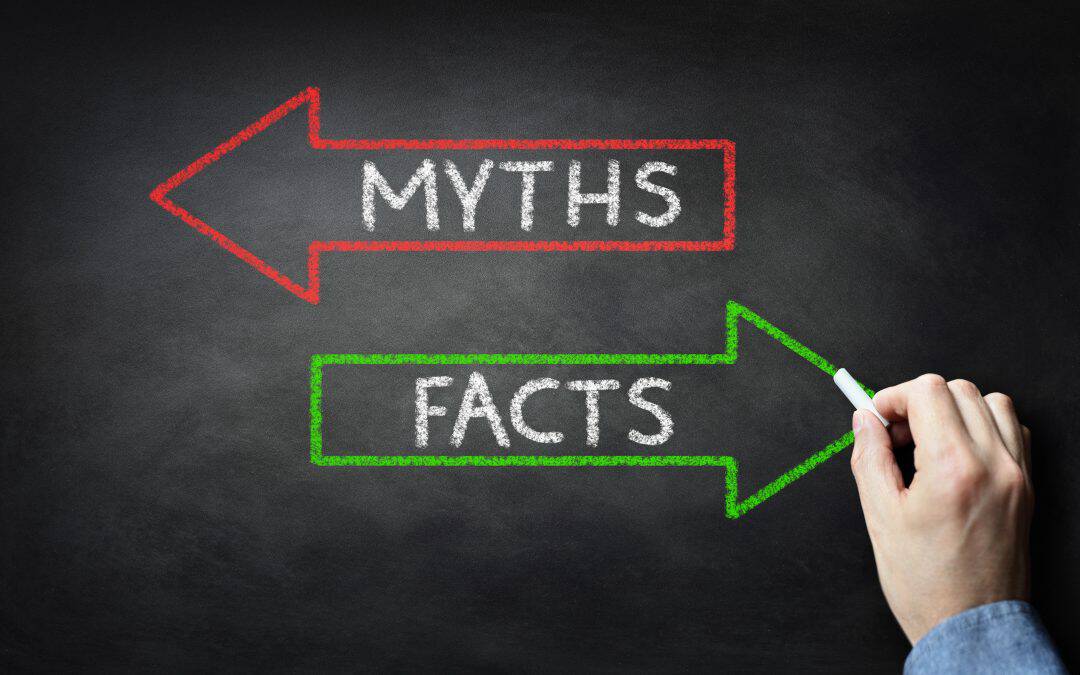
7 Common SEO Myths and Mistakes Debunked in 2024

Surprisingly, 96.55% of pages don’t pull organic traffic from Google, often due to outdated or misguided SEO tactics. This fact demonstrates why you need to recognize and avoid SEO myths that could derail your digital success.
Though SEO remains a shifting terrain, it’s possible to navigate it and steer clear of those myths and their resulting mistakes. In this guide, we’ll give actionable insights about what you should and shouldn’t do to increase your page’s visibility and boost your SEO strategy.
What Are Some Common SEO Myths Debunked?
Don’t let these SEO myths take your content strategy in the wrong direction.
Myth 1: Using High-Volume Keywords Is Enough
Instead of trying to win the battle for highly competitive, high-volume keywords, build your SEO strategy around the right topics and user intent. Keyword intent is the reason behind a searcher’s query in a search engine.
For example, you could use the keyword “apple” to target people looking for the fruit. However, they may be looking for Apple, Inc., the technology company. If your content centers around fruit when your audience wants tech information, your search rankings will drop because your information misses the primary search intent.
Keep in mind that intent falls into four main categories:
- Informational intent: Users are looking for facts or answers.
- Example: “What is the best diet?”
- Navigational intent: Users want to visit a specific website or page.
- Example: “Apple iPhone support.”
- Transactional intent: Users intend to make a purchase or complete an action.
- Example: “Buy iPhone 13.”
- Commercial investigation: Users are considering a purchase and want to compare options.
- Example: “iPhone vs. Samsung Galaxy reviews.”
Aligning your content with the appropriate intent meets user expectations and improves your search rankings.
Myth 2: You Don’t Have To Worry About Technical SEO
Technical SEO involves the behind-the-scenes aspects that ensure your site runs smoothly. Any advice to ignore it falls squarely into the category of SEO myths.
A fluid site appeals to your target audience and search engines. Neglecting technical SEO leads to:
- Slow loading times: Slow websites frustrate visitors and may make them leave before viewing your material. For example, if load times drop to three seconds from one, your bounce rate jumps 32%.
- Duplicate content: Pages with identical or almost identical content waste your crawl budget and dilute your backlinks. Consequently, the pages you want to rank higher might not get enough attention because users are going to less important pages on your site.
- Broken links: A link is like a promise of extra treasure troves of information, so broken links are like broken promises. Users lose confidence in you and go elsewhere if they can’t find the information you’ve promised them.
Allocate time and resources for technical SEO to keep your target audience and the algorithm happy.
Myth 3: Adding More Is Always Better

Trying to increase rankings with keyword stuffing is one of the most common SEO myths debunked long ago. In fact, content creators who stick to those tactics can even get banned from Google. Still, you can have overkill on your site in other ways.
For example, it’s true that 2,000-word blog posts can provide more value to readers and establish thought leadership. However, if your pages are unnecessarily wordy or full of fluff, readers will leave quickly, harming your SEO rankings.
The same goes for the number of web pages on your site. Again, a site that is a veritable library with hundreds or thousands of pages improves its odds of rankings. However, if it’s full of spammy or lightweight material, your site will look low-rent, and your rankings tank.
Quality should come along with quantity in SEO. Create top-notch pages, or hire a reliable firm to help you do so.
Myth 4: Mobile Optimization Isn’t Crucial for SEO
Thinking that mobile users’ needs aren’t important is one of the worst SEO myths because 63% of organic searches are from mobile users. So, websites that aren’t mobile-friendly risk losing a big part of their audience. To remedy this:
- Build a responsive design: Ensure your website adjusts to any screen size. Accommodate phones, tablets, and desktops.
- Simplify navigation: Keep menus short and sweet. Mobile users should find what they need easily.
- Decrease load times: Compress images and streamline your code to speed up loading on smaller, less powerful devices. Remember, faster sites hold users’ attention better.
- Include touchable elements: Buttons and links should be easy to tap on a touch screen. Make sure they are big enough and have enough space between them to avoid errors.
Cater to the mobile market, and your SEO will thrive.
Ready To Boost Your SEO Success With BKA Content?
Do you want to be sure you dodge these and other SEO pitfalls? Consult with BKA Content today for personalized SEO blog writing plans that ensure your content reaches and resonates with your audience.
What Are Some Common SEO Mistakes?
SEO myths lead to SEO mistakes that you also need to lay to rest, so look out for the following traps.
Mistake 1: Relying Too Heavily on Automation
It’s necessary to use some level of automation for SEO or content creation. You shouldn’t believe, however, that you can just “flip a switch” and get great content or optimization.
Automated tools work for repetitive tasks, such as collecting data for SEO audits. What they lack is the human touch that helps you connect with readers. AI writing alone becomes soulless and repetitive, missing the mark on style, tone, and relevance.
A more effective approach combines technology’s productivity with the knowledge of an experienced content writer. Use SEO tools, for example, to find popular subjects and keywords. Then, let someone else write the article or post. The content feels more engaging and tailored this way.
Just remember that most SEO myths and mistakes come from the idea that there’s some kind of shortcut to success. Make sure you’re putting in the appropriate effort. If you can’t do it on your own, an experienced agency can help.
Mistake 2: Neglecting Local SEO

Locals should be part of your target audience, even if you sell to a national or international client base. People often feel good about supporting homegrown companies when possible, gaining a sense of pride when doing so.
To use local SEO effectively:
- Optimize for Google My Business: Claim your Google My Business listing. Keep it updated with your latest contact information, hours, and services to improve your visibility in local search results and on Google Maps.
- Local keywords: Use keywords in your content that reflect your local area. If you’re a bakery in Atlanta, phrases like “best Atlanta bakery” or “Atlanta wedding cakes” can help locals discover you more easily.
- Content marketing for local reach: Write blog posts or articles about local events or activities related to your business. It boosts your SEO and shows that you’re engaging with your community.
Interestingly, 46% of every Google search is for something local. Just say “No” to the SEO myth that local SEO is not important. Let it help your business stand out in your community and draw people from your area who need your services.
Mistake 3: Underestimating the Power of Analytics
Not gaining insights from your SEO analytics is like trying to hit a target blindfolded. Analytics give you a clear picture of how well your content and website are doing. It also shows you what is and isn’t working. To think you can efficiently draw in traffic without tracking metrics is to fall prey to one of the most harmful SEO myths.
Analytics show you how many people visit your site, what their dwell time is, and which pages they visit the most. By understanding these patterns, you can make informed decisions that enhance your SEO strategy and improve your site’s overall performance.
Start by:
- Tracking visitor behavior: See which pages are popular and keep visitors engaged. Use this info to replicate successful elements across your site.
- Identifying traffic sources: Knowing where your traffic comes from helps you focus your marketing efforts more effectively. If a lot of traffic comes from social media, for instance, you know to invest more in using those platforms.
- Measuring conversion rates: Find out which pages lead to actions, such as newsletter sign-ups or purchases. Enhance these pages to convert even more visitors.
Analytics help you create more engaging and effective content to meet your audience’s needs. These insights from hard data ensure your marketing efforts constantly evolve and improve.
Avoid the Pitfalls of SEO With Help From Our Experts at BKA
As search engine algorithms update and marketing evolves, new SEO myths will arise. However, you won’t have to wonder about how to keep up with the trends with an experienced content creation agency in your corner. Partner with us at BKA Content today to discover a winning approach with our managed SEO writing services!
- Why Your Google Business Profile Description Might Be Blocking Map Pack Rankings - December 22, 2025
- How to Get a Location Page to Rank in 24 Hours (Without Waiting Months) - December 18, 2025
- How To Create A Google Business Profile - December 12, 2025



